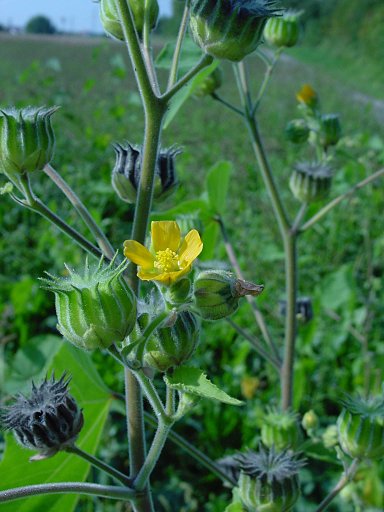
Abutilon theophrasti, photo by Precision Crop Protection
Velvet Leaf is a commercial failure but a successful foreign invader. A flop as a fiber plant and cursed for its infiltration of food crops, it was first cultivated in China some 3,000 years ago. From there Abutilon theophrasti made its way nearly everywhere on earth. First the Mediterranean area, then Europe. It was introduced into North America before 1750 to make rope but never became popular for that. Instead it became an agricultural pest. That is has edible parts went by the wayside.
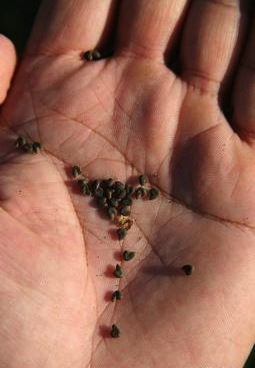
Velvet Leaf Seeds, photo by Robert Videki
The unripe seeds are edible raw. Where the plant is native its seeds are a common outdoor snack of children. Ripe seeds, however, must be leached until not bitter. Then dried they are ground into flour. Usually the flour was used to make noodles. The seeds contain between 15 and 30% oil. Even though the plant has edible seeds — young seeds taste similar to sunflower seeds — it ends up on the bottom of surveyed edible species in China because there are better alternatives. Worldwide there are some 160 species in the genus with several being used for food in various ways among them Abutilon guineense and Abutilon megapotamicum. With A. guineense the flowers are consumed raw and leaves are eaten like Marsh Mallow. The seeds are also cooked and eaten but it they are more valued for their expressed oil. A. megapotamincum’s flowers are eaten like vegetables.
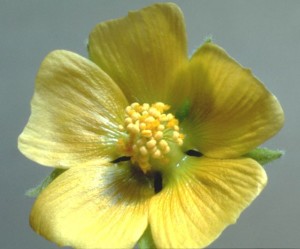
Velvet Leaf Blossom, photo by King County
Usually Abutilon theophrasti is found near farming activities: gardens, crop fields, nurseries, orchards, groves and the like. It’s significant problem where corn, cotton or soybeans are grown sometimes displacing 35% or more of the crop causing losses in the hundreds of millions of dollars. As a fiber source in Asia it has been used for rope, bags, coarse cloth, fishing nets, paper stock even caulking boats.
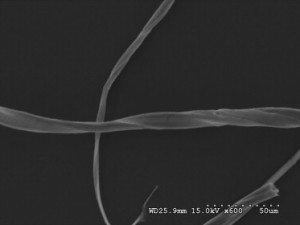
Single Velvet Leaf Fibers, photo from Bioresource Technology
In today’s world of artificial fibers it is difficult to imagine how important the plant fiber was to society hundreds of years ago, not only for clothes but for every day life. Consider sailing: All shipping relied on rope. Most ships carried several 120-fathoms (720-foot) long ropes. The USS Constitution had seven such ropes. A large ship could have 3.5 miles of rope that had to be replaced every two to four years. Companies that made cordage were called “ropewalks.” The first one opened in Boston in 1641. By 1794 there were 14 ropewalks in that city alone. In 1810 there were 183 ropewalks in the young United States. During those early years fiber for rope making was imported from Europe or Russia, which concerned the U.S. Navy then just as critical materials from hostile sources are a concern today. In 1825 it was reported that:
In answer to the resolutions of the Senate of the United States, of the 17th of May last, that the President of the United States be requisitioned to cause a report from the Secretary of the Navy to be laid before the Senate at the commencement of the next session of Congress showing the reasons, if any, why canvas, cable and cordage, made of hemp, the growth of the United States, may not be used in the equipment of national vessels with equal advantage as if of foreign fabrics or materials.
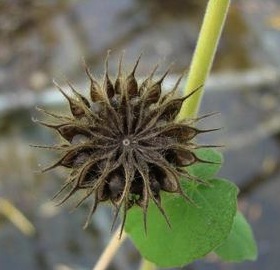
Ripe Seed Pod, photo by Invasive.org.
In 1751 the Gardener’s Dictionary by Phillip Miller describes Abutilon as: “The first sort here mentioned is an annual plant, which is hardy enough to come up in the common ground, and will perfect its seeds without any trouble; but does not bear to be transplanted, unless when the plants are very young, so that the seeds should be sown where the plants are designed to remain; and if the seeds are permitted to fall, they will come up the following spring without any care. This is very common in Virginia and most of the other parts of America; where it is called by some of the inhabitants Mash-mallow, because the leaves are soft and woolly. There is not great beauty in this sort.” There’s actually a little more to that story. Miller (1691-1771) chief gardener at the Chelsea Physic Garden from 1721 until his death, didn’t like Carl Linnaeus’ binomial system even after meeting Linnaeus in 1736. Thus Miller didn’t create the Albutilon genus until 1768, three years before he died getting it into his seventh edition of his Gardener’s Dictionary. Theophrasti was added some 21 years later by Friedrich Casimir Medicus (1736-1808) director of the garden at Mannheim during the late 18th century. He, too, had a bit of a naming snit with Linnaeus.
Over the next 120 years much effort was made to create a home-grown fiber industry in the United States. Meanwhile Velvet Leaf was becoming an agricultural pest in food crops. An Illinois committee report in 1871 alluded to the growing problem. The committee said it had: ” … examined the fiber as exhibited on the stalk, and as dressed for use, in its various colors and qualities and as made into thread, cordage and ropes, and consider that its promise of permanent utility is indeed quite flattering. We have no doubt but that this detestable weed will be found far more valuable in (the) future, in our ropewalks, than it has heretofore proven in our corn fields.” The committee added it hoped: … Illinois and the great Northwest may yet find, in this hetherto most common and noxious weed, a plant of great profit to their people…” In the end Velvet Leaf never became the great promised fiber plant in North America because of the lack of machinery to economically process it.
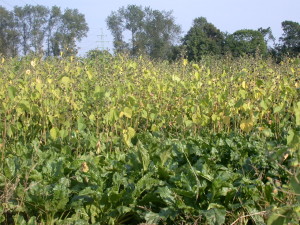
A stand of Velvet Leaf, photo by Precision Crop Protection
In the greater mallow family Abutilon (ah-BLEW-tee-on) is from an Arabic name for a similar plant, which is not much help in identification. The word was created around 900 B.C., by Avicenna-or Ibn-Sina for plants resembling a mallow or mulberry. The species name isn’t much help either, Theophrasti. That means “of Theophrastus.” Unfortunately Theophrastus is not a place but a Greek, born around 370 BC who lived to be 82 or so and is considered the ‘father of botany.’ He wrote several books on the history of plants and six books on “The Causes of Plants.” A student of Aristotle, he might have mention the plant or something like it in one of his books. Guineense means ‘of Guinea’ and megapotamicum is Dead Latin for Rio Grande which means big river. A. megapotamicum grows near the Rio Grande. Other common names for Velvet Leaf include: Buttonweed, Indian Mallow, Butterprint, China Jute, Abutilon Hemp, Manchurian Jute, American Jute, Tientsin Jute, Piemaker, and in Chinese Ching-ma. It’s debatable whether the plant is native to India or China.
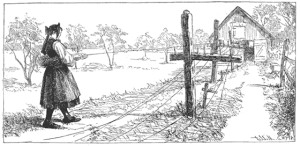
A reversed pen drawing entitled “A Rope-walk” by Frank Millet shows a Vierlande maid crafting rope in the traditional way.
Besides North America Velvet Leaf is native or naturalized in China, India, Iran, Israel, Japan, Kazakhstan, South Korea, Pakistan, Turkey, Bulgaria, Croatia, Denmark, the Former Yugoslavia, France, Germany, Greece, Hungary, Italy, Netherlands, Poland, Portugal, Romania, the Russian Federation, Slovenia, Spain, Sweden, Switzerland, Ukraine, United Kingdom. Eritrea, Ethiopia, Morocco, Canada and the United States.
Green Deane’s “Itemized” plant profile: Velvet Leaf
IDENTIFICATION: Abutilon theophrasti is a subshrub to about six feet, or two meters, often just a few feet. The stem and twigs are covered with fine hair. Leaves are heart-shaped and alternate. They are very fuzzy and have just a hint of teeth around the edge. One flower per leaf axils is produced, yellow, five petals, slightly notched. Self-pollinating each plant can produce up to 17,000 seeds and the seeds can remain viable for 60 years. One researcher reported 43% seed germination after 39 years of burial. Seed pods are usually densely covered with soft bristles. Nearly black at maturity. The seed capsule has a cup-like ring formed by 12 to 15 woody segments that remain intact at maturity. Each segment releases one to three seeds through a vertical slit on the outer face of the capsule. Seeds range from kidney shaped to almost triangular, have a notch, are flattened, and about one eighth of an inch long, purplish brown, brown, or black, smooth or have tiny star-shaped hairs
TIME OF YEAR: Leafs out in spring, flowers in the summer, seeds in fall, hardy to zone 4 and is found in North America between 32 and 45 degrees north.
ENVIRONMENT: Likes well-drained neutral soil high in nitrogen (read agricultural land.) Moist. Full sun, will tolerate some shade. Seeds, adult plants, and decaying plant contain or produce allelopathic chemicals limiting the growth of surrounding crop plants.
METHOD OF PREPARATION: Unripe seeds raw, ripe seeds leached of bitterness, dried, then ground into flour. In other species flowers and or young leaves are edible. Oh… one last thing. The leaves can be used as toilet paper.
To see a short video on the plant as a source of fiber go here.

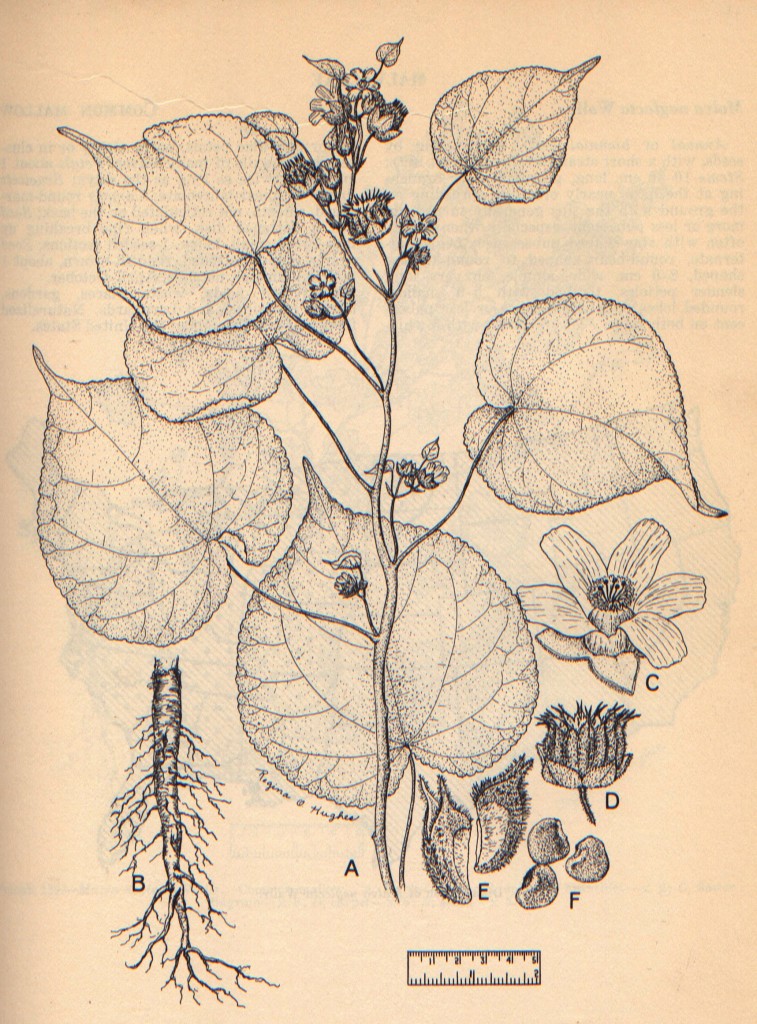

I never realized before that velvet leaf could be used for fiber. As a spinner and weaver that is important to me. I know we used to live in a place with plenty of velvet leaf, but I can’t think that I’ve seen much of it where we live now. I’ll keep my eye out for it though!
how would one make a fiber out of it? I too am a spinner and knitter Barbara. I have a medium size property and in the back part found this wonderful plant there. I didn’t know what it was at first so i let it grow up and now i am like… this must be important as it had too many features to it that seemed useful. glad i know what it is now!
anyone have any input in how the fibers can be extracted? Is it treated like flax?
I would gladly send you some seeds!
Hi Elaine,
Do you have some velvetleaf seeds? I would like a few.
Thanks,
Catherine
Please be careful! This plant is listed as a noxious weed! It would be better to find places where it already grows, and try to help some farmer who is battling this plant rather than propagate it–encourage native plants instead. I work in conservation and see many unbalanced landscapes changing rapidly due to invasive plants, which don’t need our encouragement–my humble opinion.
WOW! The seeds are good for 60 YEARS! Seams there is a bit of a miracle here with this little so called pest. Super cool facts. Thanks!
Dear,i am from India,i need some seeds of said plant,if you can send me,then plz mail me……..musheer123ni@gmail.com…..it would be your high regarads if you will do same in my favour…
Hi MushirKushit, can u pl call me on 9860160801.
– Walmik, Pune-Maharashtra.
I have been wondering what these plants have been for over 5 years, I saw no purpose and yet I still have not gotten ride of them in my veggie garden. I’d be happy to send you a seed package but I can’t until Autumn. Plz remind me in August.
I would love to have some seeds
Would love to but not until Autumn. Remind me in August
A lifetime of FREE torliet paper and flour!! lol
haha I’ve ALWAYS used them for TP. Farmer’s daughter here.
Sounds like a great survivalist plant to me.
Hey Deane, do the dry pods on this plant make a rattling nose when you walk through them?I think I’ve walk through a field of these in lake Wales Florida when I was younger. we didn’t know what to call them but now ill be sure to eat em when I see them again
No, it does not grow locally. What you are recalling might be rattlebox, which is highly toxic. Don’t eat it.
That could be columbine.
Been wondering what this was.found one under my bird feeder last yr.liking your site. Enjoy picking some “weeds”while I walk my dog.
I have what appears to be ,Velvet Leaf but it is now 10 ft tall and 4 yrs. old, not annual, has never bloomed, has a stem 2.5 in thick that looks like a tree trunk, light brown with ivory flecks, but side stems are hollow so I guess the main stem is also hollow. Mature leaves are close to a foot wide and long. It’s against a south wall at 40 degrees latitude, so is in velvet leaf’s range but might be in a microclimate spot. Other suggestions as to what it might be?
Got a picture that can be posted on the Green Deane Forum?
If it dies back every year it might be a Paulonia, Pawlownia? or Empress tree. They have huge leaves and first year plants will easily grow ten feet in a season. Mature trees resemble a Catalpa tree from a distance, but the flower clusters are lavender. The young leaves can be the size of dinner plates. Can’t think of any other northern plant with leaves that big.
That thought crossed my mind a few decades ago but it just never worked well. Vodka, and watered-down vodka did not work. It has to be a low-percentage of alcohol to start with, and I suspect, it also needs to smell to attract the flies.
Maybe it’s a catalpa tree. That’s what I thought my velvet leaf was at first.
This describes what I have growing along my fence. Be interesting to see exactly what is and anything useful about it.
Just a heads-up that the pronunciation is ah-BEAUT-ill-on. Abutilon.
There see many opinions on how Dead Latin should be said.
There are various opinions on how to say Dead Latin.
Avicenna was born in 980 of the Common Era, so 900 B.C. should be corrected so “after 1000 A.D.” — Velvetleaf is *beautiful* — and the leaves are indeed velvety (although only on the living plant). Less monocropping, please. — Dead Latin? Modern scientific Latin, English version = uh-BEAUT-i-lon (eau as in beauty); European version = uh-BOO-ti-lon (as in boo for Hallowe’en). The original Arabic definitely has a “boo” (not “byoo”). With all my love to plants and their people, –gk
I would like to know how to process the fibre aspect of this plant, as rope, yarn and paper! Please. Tks I also wonder about using this leaf as toilet paper as I understand the leaves to be an irritant.
I found this plant growing in my front yard and had no idea what it was. Took it to school to identify it after it grew to 6 feet in one month. Suspected it to be a bad weed and burned it up.
Ah, so this is what showed up in my garden the past few years. I always let a few of them grow because they look neat with their broad leaves and little yellow mallow flowers. Compared to other garden weeds (such as quackgrass’ wildly spreading rhizomes and Bermuda grass’ tough root mass and prolific spread), it’s easy to remove so I never thought of it as much of a pest. Now I know I can actually use it for something, so I may make a patch just for it next year to experiment with.
So, I just watched a video where a woman oven-dried the ripe seeds and ground them into flour to make bread (which she later ate in another video)…she never “leached” them and I can’t find out any further information on that process, nor exactly what it is supposed to do, chemically speaking.
I understand that this article says it is to “reduce bitterness”, but the woman in the video didn’t remark about her bread being bitter, only “nutty”, so…I’m wondering if leaching is even necessary? Does anyone else know for sure? Is leaching necessary? If so, why? (Will there be any illness or toxic results if it isn’t done?) If so, HOW? Same as acorns or what??? Thanks!
I have a ton of these. Thought they were my bean plants, guess not. Anyone find any way to safely make the seeds into flour?
I grew a number of the plants last year and roasted the seeds in a flat layer on a cookie sheet at about 400F for about 5-10 minutes until they smelled like roasted peanuts (they are quite aromatic when roasted). You’ll want to stick around because they are a bit variable in roasting time depending on their water content and since they’re small they can burn quickly. Then I took them out and cooled them quickly on another cookie sheet. Afterward, I ground them in a coffee mill on the finest grind. Mixed 1 cup with 3 cups of regular flour and got some decent bread out of them. It has a nice nutty flavor and a heavier texture that works well for bruschetta.
By way of anecdote, Deane, we first encountered this weed on our small farm in Ohio about 20 years ago. It had sprouted up in the horse pasture and our draft pony proceeded to eat a LOT of it. After about 36 hours of her standing in that patch, she started to develop colic. We had to clean her out with warm water, (oh what FUN) and she passed a large, hard ball of fibers. Our vet explained that because the flowers and leaves are so tasty, horses will eat the whole plant, and the fiber becomes an indigestible mass. Never knew we could eat the stuff too. I know some farmers who would be happy to be rid of it.
I would like to know how to make a poultice for wounds and how to make a Tea-for what purpose.
I have this growing in my yard had no idea what it was thought it was beans
Took me forever to find out what it was till today
I let a bunch of these grow next to my garden this year because they start off so small and cute. Then I didn’t have the heart to kill them. Now they are in the 6foot range and have their seeds are ripe and the plants are ready to be harvested. It’s such a shame I don’t have much use for them as the leaves and even the stalks are so incredibly soft and smooth. I can here searching for something to do with them but haven’t heard a response on how to make fabric with them and I rather harvest the seeds than to eat them. If anyone wants some of the seeds email me at niiiru@gmail.com.
What is a similar plant that grows here in Central Florida?
I’ve found something growing across from my driveway that has seed pods that look like Abutilon theophrasti and the leaves are very soft and velvety. The Flowers look similar though they are kind of a peach color and the seeds seem to be much smaller. Which species grows here?
Perhaps you’ve encountered A. hulseanum, colloquially known as Red Indian Mallow or Mauve? Grows in my area of central FL according to http://florida.plantatlas.usf.edu.
I ate one of the fruits out of curiosity. They have kind of a melon taste with a slightly bitter after taste. Not sure if the whole fruit is safe to eat but it doesn’t taste too bad. I knew the leaves , flowers and seeds were edible so I figured the fruit would not hurt. I suffered no ill effects but I only ate one fruit.
Perhaps this method could be used for making yarns from the velvetleaf plant.
https://www.google.com/search?client=safari&rls=en&q=making+linen+out+of+flax&ie=UTF-8&oe=UTF-8#kpvalbx=_Tj2bXejwGMW3ggfr2Y8Q31
i have 1 of these in my vegtable garden, i pluckedoff all the seed pods so my garden isnt full of them next yr, but nw i know i can eat the seeds in the green pods! thanks!
Just discovered I have a few of these little plants growing in my yard. Any chance this plant could overtake and kill Japanese Knotweed?
Did you know that the flowers and roots of the velvet plant (Abutilon theophrasti) have been used as a natural medicine for liver health in parts of Central and Eastern Europe? I wrote an article about it if you are interested in learning more: https://www.mynaturaltreatment.com/natural-remedies-for-liver-health/#4_Velvetleaf_Remedy_for_Liver_Health
I read the unripe seeds are edible, while mature need to be leached. Important to know as some beans are toxic raw and need to be soaked, often lye was used then rinsed. Saponins in high amounts are toxic. It was used to make soap and detergents. Beans when eaten two to three times a week, can over several years clean out arteries one study suggested as saponins are beneficial. Of course the level in cooked rinsed beans is much less than raw.
Catalpa often have caterpillars Fisher prize them for that reason. One avid fisherman grew the trees just for fish bait.